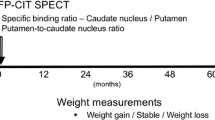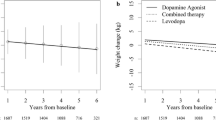Abstract
Fluctuating body weight is a commonly reported nonmotor feature in patients with Parkinson’s disease (PD). We hypothesised that striatal dopamine transporter (DAT) density at the time of diagnosis might play an important role in weight regulation in patients with PD. DAT density was measured from 123I-FP-CIT single-photon emission computed tomography. Region-of-interest analyses were performed to measure the specific binding of 123I-FP-CIT to DAT, and the putamen-to-caudate nucleus ratio (PCR) was calculated. Body weight was measured at baseline (W0) and at 48 months (W48). We classified subjects into three groups: weight loss, stable, and weight gain. In final analyses, 163 patients (106 men, 57 women) were included. PCR significantly differed by group in men, but not in women or across all patients. In men, PCR was slightly negatively associated with the percentage change in weight. No such correlation was found across all patients or in women. In univariate and multivariate logistic regression analyses, low PCR was associated with future weight gain in men with PD but not in women. In conclusion, striatal DAT availability at the time of diagnosis could predict subsequent weight change in men with PD.



Similar content being viewed by others
Change history
03 May 2023
A Correction to this paper has been published: https://doi.org/10.1007/s00702-023-02637-2
References
Balestrino R, Baroncini D, Fichera M, Donofrio CA, Franzin A, Mortini P, Comi G, Volonte MA (2017) Weight gain after subthalamic nucleus deep brain stimulation in Parkinson’s disease is influenced by dyskinesias’ reduction and electrodes’ position. Neurol Sci 38(12):2123–2129. https://doi.org/10.1007/s10072-017-3102-7
Barichella M, Cereda E, Pezzoli G (2009) Major nutritional issues in the management of Parkinson’s disease. Mov Disord 24(13):1881–1892. https://doi.org/10.1002/mds.22705
Berridge KC, Ho CY, Richard JM, DiFeliceantonio AG (2010) The tempted brain eats: pleasure and desire circuits in obesity and eating disorders. Brain Res 1350:43–64. https://doi.org/10.1016/j.brainres.2010.04.003
Bobzean SA, DeNobrega AK, Perrotti LI (2014) Sex differences in the neurobiology of drug addiction. Exp Neurol 259:64–74. https://doi.org/10.1016/j.expneurol.2014.01.022
Brovelli A, Nazarian B, Meunier M, Boussaoud D (2011) Differential roles of caudate nucleus and putamen during instrumental learning. Neuroimage 57(4):1580–1590. https://doi.org/10.1016/j.neuroimage.2011.05.059
Connolly BS, Lang AE (2014) Pharmacological treatment of Parkinson disease: a review. JAMA 311(16):1670–1683. https://doi.org/10.1001/jama.2014.3654
Conover W (1999) Practical Nonparametric Statistics, 3rd edn. Wiley, Hoboken
Crandall CJ, Yildiz VO, Wactawski-Wende J, Johnson KC, Chen Z, Going SB, Wright NC, Cauley JA (2015) Postmenopausal weight change and incidence of fracture: post hoc findings from Women’s Health Initiative Observational Study and Clinical Trials. BMJ 350:h25. https://doi.org/10.1136/bmj.h25
Cumming K, Macleod AD, Myint PK, Counsell CE (2017) Early weight loss in parkinsonism predicts poor outcomes: evidence from an incident cohort study. Neurology 89(22):2254–2261. https://doi.org/10.1212/WNL.0000000000004691
Garcia-Gomez FJ, Garcia-Solis D, Luis-Simon FJ, Marin-Oyaga VA, Carrillo F, Mir P, Vazquez-Albertino RJ (2013) Elaboration of the SPM template for the standardization of SPECT images with 123I-Ioflupane. Rev Esp Med Nucl Imagen Mol 32(6):350–356. https://doi.org/10.1016/j.remn.2013.02.009
Giovannoni G, O'Sullivan JD, Turner K, Manson AJ, Lees AJ (2000) Hedonistic homeostatic dysregulation in patients with Parkinson's disease on dopamine replacement therapies. J Neurol Neurosurg Psychiatry 68(4):423–8
Gupta A, Mayer EA, Hamadani K, Bhatt R, Fling C, Alaverdyan M, Torgerson C, Ashe-McNalley C, Van Horn JD, Naliboff B, Tillisch K, Sanmiguel CP, Labus JS (2017) Sex differences in the influence of body mass index on anatomical architecture of brain networks. Int J Obesity 41(8):1185–1195. https://doi.org/10.1038/ijo.2017.86
Joel D, Weiner I (2000) The connections of the dopaminergic system with the striatum in rats and primates: an analysis with respect to the functional and compartmental organization of the striatum. Neuroscience 96(3):451–474
Kenny PJ (2011) Reward mechanisms in obesity: new insights and future directions. Neuron 69(4):664–679. https://doi.org/10.1016/j.neuron.2011.02.016
Kumru H, Santamaria J, Valldeoriola F, Marti MJ, Tolosa E (2006) Increase in body weight after pramipexole treatment in Parkinson’s disease. Mov Disord 21(11):1972–1974. https://doi.org/10.1002/mds.21086
Lee JJ, Oh JS, Ham JH, Lee DH, Lee I, Sohn YH, Kim JS, Lee PH (2016) Association of body mass index and the depletion of nigrostriatal dopamine in Parkinson’s disease. Neurobiol Aging 38:197–204. https://doi.org/10.1016/j.neurobiolaging.2015.11.009
Marras C, Chaudhuri KR (2016) Nonmotor features of Parkinson’s disease subtypes. Mov Disord 31(8):1095–1102. https://doi.org/10.1002/mds.26510
Nandhagopal R, Kuramoto L, Schulzer M, Mak E, Cragg J, Lee CS, McKenzie J, McCormick S, Samii A, Troiano A, Ruth TJ, Sossi V, de la Fuente-Fernandez R, Calne DB, Stoessl AJ (2009) Longitudinal progression of sporadic Parkinson’s disease: a multi-tracer positron emission tomography study. Brain 132(Pt 11):2970–2979. https://doi.org/10.1093/brain/awp209
Nirenberg MJ, Waters C (2006) Compulsive eating and weight gain related to dopamine agonist use. Mov Disord 21(4):524–9
O’Connor RM, Kenny PJ (2016) Role of striatal dopamine signaling in compulsive eating associated with obesity. Curr Opin Behav Sci 9:152–157. https://doi.org/10.1016/j.cobeha.2016.04.014
Oh M, Kim JS, Kim JY, Shin KH, Park SH, Kim HO, Moon DH, Oh SJ, Chung SJ, Lee CS (2012) Subregional patterns of preferential striatal dopamine transporter loss differ in Parkinson disease, progressive supranuclear palsy, and multiple-system atrophy. J Nucl Med 53(3):399–406. https://doi.org/10.2967/jnumed.111.095224
Pak K, Kim K, Lee MJ, Lee JM, Kim BS, Kim SJ, Kim IJ (2018a) Prediction of future weight change with the dopamine transporter. Brain Imaging Behav. https://doi.org/10.1007/s11682-018-9878-0
Pak K, Shin HK, Kim EJ, Lee JH, Lyoo CH, Son J, Lee MJ (2018b) Weight loss is associated with rapid striatal dopaminergic degeneration in Parkinson’s disease. Parkinsonism Relat Disord 51:67–72. https://doi.org/10.1016/j.parkreldis.2018.02.044
Parkinson Progression Marker I (2011) The Parkinson progression marker initiative (PPMI). Prog Neurobiol 95(4):629–635. https://doi.org/10.1016/j.pneurobio.2011.09.005
Picillo M, Nicoletti A, Fetoni V, Garavaglia B, Barone P, Pellecchia MT (2017) The relevance of sex in Parkinson’s disease: a review. J Neurol 264(8):1583–1607. https://doi.org/10.1007/s00415-016-8384-9
Ribas EC, Yagmurlu K, de Oliveira E, Ribas GC, Rhoton A Jr (2017) Microsurgical anatomy of the central core of the brain. J Neurosurg. https://doi.org/10.3171/2017.5.JNS162897
Schapira AHV, Chaudhuri KR, Jenner P (2017) Non-motor features of Parkinson disease. Nat Rev Neurosci 18(7):435–450. https://doi.org/10.1038/nrn.2017.62
Small DM, Jones-Gotman M, Dagher A (2003) Feeding-induced dopamine release in dorsal striatum correlates with meal pleasantness ratings in healthy human volunteers. Neuroimage 19(4):1709–1715
Stice E, Yokum S, Blum K, Bohon C (2010) Weight gain is associated with reduced striatal response to palatable food. J Neurosci 30(39):13105–9
Szczypka MS, Kwok K, Brot MD, Marck BT, Matsumoto AM, Donahue BA, Palmiter RD (2001) Dopamine production in the caudate putamen restores feeding in dopamine-deficient mice. Neuron 30(3):819–828
Tzourio-Mazoyer N, Landeau B, Papathanassiou D, Crivello F, Etard O, Delcroix N, Mazoyer B, Joliot M (2002) Automated anatomical labeling of activations in SPM using a macroscopic anatomical parcellation of the MNI MRI single-subject brain. Neuroimage 15(1):273–289. https://doi.org/10.1006/nimg.2001.0978
Volkow ND, Wang GJ, Baler RD (2011) Reward, dopamine and the control of food intake: implications for obesity. Trends Cogn Sci 15(1):37–46. https://doi.org/10.1016/j.tics.2010.11.001
Wills AM, Perez A, Wang J, Su X, Morgan J, Rajan SS, Leehey MA, Pontone GM, Chou KL, Umeh C, Mari Z, Boyd J (2016) Association between change in body mass index, Unified Parkinson’s Disease Rating Scale Scores, and survival among persons with Parkinson disease: secondary analysis of longitudinal data from NINDS Exploratory Trials in Parkinson Disease Long-term Study 1. JAMA Neurol 73(3):321–328. https://doi.org/10.1001/jamaneurol.2015.4265
Yager LM, Garcia AF, Wunsch AM, Ferguson SM (2015) The ins and outs of the striatum: role in drug addiction. Neuroscience 301:529–541. https://doi.org/10.1016/j.neuroscience.2015.06.033
Yoest KE, Quigley JA, Becker JB (2018) Rapid effects of ovarian hormones in dorsal striatum and nucleus accumbens. Horm Behav 1:2–3. https://doi.org/10.1016/j.yhbeh.2018.04.002
Yoshida M (1991) The neuronal mechanism underlying parkinsonism and dyskinesia: differential roles of the putamen and caudate nucleus. Neurosci Res 12(1):31–40
Acknowledgements
PPMI, a public–private partnership, is funded by the Michael J. Fox Foundation for Parkinson’s Research and funding partners, including AbbVie, Avid, Biogen, Bristol-Myers Squibb, COVANCE, GE Healthcare, Genentech, GlaxoSmithKline, Lundbeck, Lilly, Merck, Meso Scale Discovery, Pfizer, Piramal, Roche, Sanofi Genzyme, Servier, TEVA, and UCB. This work was supported by a 2-Year Research Grant of Pusan National University.
Author information
Authors and Affiliations
Corresponding author
Additional information
Publisher's Note
Springer Nature remains neutral with regard to jurisdictional claims in published maps and institutional affiliations.
Kyoungjune Pak, Heeyoung Kim and Youngduk Seo contributed equally as first authors. Kyoungjune Pak and Myung Jun Lee contributed equally as corresponding authors.
Rights and permissions
Springer Nature or its licensor (e.g. a society or other partner) holds exclusive rights to this article under a publishing agreement with the author(s) or other rightsholder(s); author self-archiving of the accepted manuscript version of this article is solely governed by the terms of such publishing agreement and applicable law.
About this article
Cite this article
Pak, K., Kim, H., Seok, J.W. et al. Prediction of future weight change with dopamine transporter in patients with Parkinson’s disease. J Neural Transm 126, 723–729 (2019). https://doi.org/10.1007/s00702-019-02016-w
Received:
Accepted:
Published:
Issue Date:
DOI: https://doi.org/10.1007/s00702-019-02016-w




